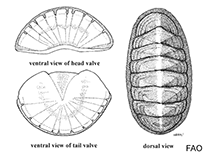Lepidozona albrechtii (Schrenck, 1862)
Albrecht's chiton| Native range | All suitable habitat | Point map | Year 2050 |

|
| This map was computer-generated and has not yet been reviewed. |
| Lepidozona albrechtii AquaMaps Data sources: GBIF OBIS |
Upload your photos
Google image | No image available for this species;
drawing shows typical species in Ischnochitonidae.
Google image | No image available for this species;
drawing shows typical species in Ischnochitonidae.
Classification / Names Common names | Synonyms | CoL | ITIS | WoRMS
Polyplacophora | Chitonida | Ischnochitonidae
Environment: milieu / climate zone / depth range / distribution range Ecology
Benthic; depth range 0 - 60 m (Ref. 289). Subtropical
Distribution Countries | FAO areas | Ecosystems | Occurrences | Introductions
Northwest Pacific: Kuril Islands, Korea, Japan, China, and Russia.
Length at first maturity / Size / Weight / Age
Maturity: Lm ? range ? - ? cm Max length : 5.1 cm TL male/unsexed; (Ref. 283)
Short description Morphology
Body oval in shape; moderately elevated. Valve reddish, maculated with dark brown or black or occasionally blotched with creamy white. Lateral areas sculptured with many, mostly bifurcating, low, radiating ribs, bearing sparse, minute, glossy pustules. Central area with sixty five, longitudinal riblets. Girdle moderately wide, colored in alternating bands of dark reddish brown and yellowish; covered with large, loosely imbricating, almost smooth scales.
Found from intertidal to 60 m (Ref. 75835).
Life cycle and mating behavior Maturity | Reproduction | Spawning | Eggs | Fecundity | Larvae
Members of the class Polyplacophora are mostly gonochoric. Life cycle: Eggs hatch into lecitotrophic planktonic trocophore larvae (no veliger stage) which later metamorphose and settle on the bottom as young adults.
Main reference
References | Coordinator | Collaborators
Burghardt, G. and L. Burghardt. 2006. (Ref. 283)
IUCN Red List Status (Ref. 130435)
CITES status (Ref. 108899)
Not Evaluated
CMS (Ref. 116361)
Not Evaluated
Threat to humans
Harmless
Human uses
| FishSource |
Tools
More information
Internet sources
BHL | BOLD Systems | CISTI | DiscoverLife | FAO(Publication : search) | Fishipedia | GenBank (genome, nucleotide) | GloBI | Gomexsi | Google Books | Google Scholar | Google | PubMed | Tree of Life | Wikipedia (Go, Search) | Zoological Record
Estimates based on models
Preferred temperature
(Ref. 115969): 3.3 - 18.7, mean 12.2 (based on 76 cells).
Price category
(Ref. 80766):
Unknown.



